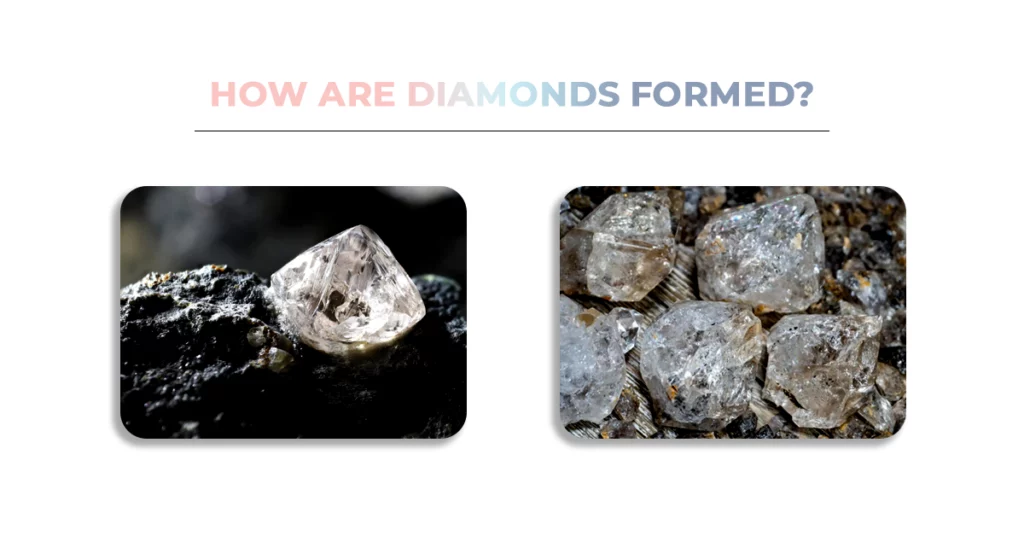
“Sustainability” and “Eco-friendly” are buzzwords surrounding any industry today, from automobiles to clothing. The same holds true in the world of jewelry, too, especially when it comes to lab-grown diamond necklaces.
Lab-grown diamond jewelry is marketed as an ethical and eco-friendly alternative to those adorned with minded diamonds. So, is there any truth to this? Let’s find out.

Natural diamonds are formed when the holy trinity of carbon-rich materials, high temperatures, and extreme pressures come together deep under the surface of the earth.
Over time (millions of years), the carbon atoms crystalize to form what we know as diamonds. Geological events such as volcanic eruptions push these precious stones closer to the surface of the earth, where we extract them by mining.
Lab-grown diamonds, on the other hand, are made in specialized laboratories that are capable of replicating the same conditions under which natural diamonds are formed with one primary difference. What Mother Earth does over a million years, they can do in a matter of weeks.

To accurately determine how environmentally friendly lab-grown diamond necklaces and other jewelry are, let’s compare them on multiple factors.
Diamond mines span over vast areas of land, especially in open pit mines. It takes over 186 sqft of land and an average extraction of 1000 tones of earth to mine a single carat of diamond.
Some of the largest diamond mines in the world, such as the Opara Diamond mine located in Botswana, cover an area of almost 1.18 sq km. Add to this further destruction of the natural habitat surrounding the mine to set up labor camps, logistic operations, and areas to dump mining waste, and you can see that disruption to the flora and fauna of the region.
On the other hand, lab-grown diamonds do not require such vast expanses of land and cause little to no impact on the natural biodiversity.
Mining of any kind has a massive water footprint, and diamond mining is no different. It takes, on average, 1000 liters of water to mine one carat of diamond.
In comparison, the High-Pressure High Temperature (HPHT) method of growing diamonds used no water, while the Chemical Deposition (CVD) method used a meager 2 liters of water per carat.
Moreover, diamond mining causes acid mine runoff, a type of water pollution that occurs when acidic water flows out of mines and contaminates surrounding water bodies. It can have a massive impact on marine life as well as human habitats that depend on them.
We are currently amidst a climate crisis, the impacts of which are being felt globally. Greenhouse gases are one of the significant contributors to global warming, and a discussion about environmental implications would be incomplete without taking into account this crucial factor.
The process of diamond mining produces about 57 kg of Carbon emissions per carat. Mining also emits about 21.43 kgs of Nitrous oxide emissions and about 7.2 kgs of Sulphur oxide emissions per carat mined.
In contrast, lab-grown diamonds result in only 0.028 grams of carbon emissions per carat, making them a much more environmentally friendlier option.
Lab-grown diamond necklaces are indeed the environment-friendly option. The environmental impact of diamond mining is staggering. The number of resources required and the environmental impact of mining a carat’s worth of diamonds is nothing short of criminal, considering the state of our planet at the moment.
That said, in all fairness, growing diamonds in a lab still requires a tremendous amount of energy. But all things considered, it is still the better choice for the environment between the two.
Are you convinced and are looking for your eco-friendly lab-grown diamond necklace? La Joya offers a wide selection of lab-grown diamond necklaces that are both exquisite and kinder to the environment. Click here to shop their collection now!
Lab-grown diamonds are created in specialized laboratories that replicate the natural diamond formation process using carbon-rich materials, extreme pressures, and high temperatures. Two primary methods are used to grow them: High-Pressure High Temperature (HPHT) and Chemical Vapor Deposition (CVD).
Lab-grown diamonds can be created in a matter of weeks, as opposed to natural diamonds, which form over millions of years. Jewellery created with them also comes at a fraction of the environmental impact when compared to those made with natural diamonds obtained via mining.
The easiest way to tell if a diamond necklace is lab-grown or mined is to look for the certification report that comes with every diamond. The report will indicate the origin of the diamond, whether it is natural or synthetic.
Yes, lab-grown diamonds are just as durable as mined diamonds. They share the same properties in every aspect, making them suitable for everyday wear and heirloom jewelry.
The process of caring for your lab-grown diamond jewelry is the same as with minded diamond jewelry. All you need is a mild soap, water solution, and a gentle brush. Avoid the use of harsh chemicals at all costs.
Shop by metal
Shop by diamond
@ All rights reserved La Joya Jewelry Inc